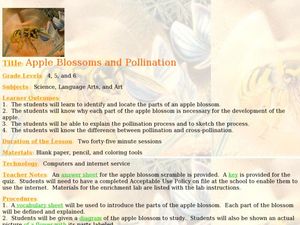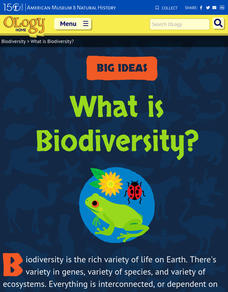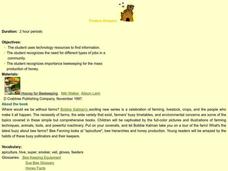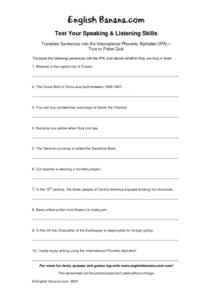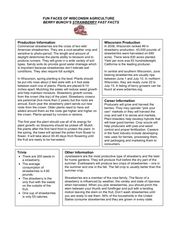Curated OER
Darwin’s Bees
What do you call a bee born in May? A maybe! This first instructional activity in a series of four begins with a starter activity to get scholars thinking about the topic. Then a circus, or circuit of seven activities, show Darwin's...
Curated OER
Buzzing Bee's Wardrobe
Students investigate the anatomy of honeybees. In this anatomy instructional activity, students research the physical characteristics of bees and discover what they do. Students create a model of a honeybee showing the correct anatomy.
Curated OER
What Bees Eat
Young scholars study plant and animal interdependence by studying bees and pollination. In this interdependence lesson, students discuss flower parts and dissect it to show its reproductive parts. Young scholars then use tissue and pipe...
Curated OER
The Disappearing Honeybees: Tracking Honeybee Decline
Middle schoolers practice graphing and other math skills to track number of honeybee colonies present in United States since 1978, discuss major crops that are dependent on insect pollinators, and examine reasons for decline of United...
Curated OER
Honey Bees!
Students research and complete two assignments about honeybees. Students draw and color a picture of a flower with a honeybee inside of it. Students write a letter to the executives at Ridit Pest Control persuading them to stop the...
Curated OER
Buzz Up My Hive
Students research bees. In this organisms lesson, students participate in various learning centers to find out more about bees. The centers include watching a video and taking notes, reading books about bees, and going on a WebQuest. As...
Curated OER
Plants And Pollination
Students describe sexual reproduction in plants, including the process of pollination, how insects assist in pollination, and how pollination differs from fertilization. They also explore the importance of honey bees to Arizona agriculture.
Curated OER
Apple Blossoms and Pollination
Students explore the concept of pollination. In this pollination activity, students examine the parts of an apple blossom and then compare and contrast pollination and cross-pollination.
Curated OER
A Honey of a Hexagon
Students explore how bees make honey and why the hexagon is the best basic pattern for the honeycomb through the use of a video and hands-on activities with honeycombs and geometric shapes.
Curated OER
Pollination Parties!
Students conduct research on a specified plant and how it is pollinated. In this pollination instructional activity, students discover how bees pollinate plants and make life better for humans. After completing research, individuals...
Cornell University
Beneficial Insects
A lot of people think of insects as pests. But actually, some insects are beneficial because they get rid of pests! After learning about beneficial insects, class members research given insects to find out if they are pests or predators.
Curated OER
Flower Reproduction
Fifth graders examine the cycle of flower reproduction. They listen to a poem about a bee, observe and examine flowers in small groups, and develop a class KWL chart. Students then read about flower reproduction in their textbook, and...
Curated OER
Fish and Flowers
Students read and discuss a research article that explains the unlikely link between increased fish populations and increased plant pollination. They answer reading guide questions to discover this ecological relationship.
American Museum of Natural History
What is Biodiversity?
Not all dogs are the same just like not all finches are the same. An interactive online lesson helps individuals learn about the causes and limitations to biodiversity. The clickable sections describe the basics of the genetics of...
Curated OER
Symbiosis: Help, Hinder or Destroy
Use background information and vocabulary to familiarize your students with the concept of symbiosis and the role agriculture plays in the shared relationship. They then write the vocabulary in their lab books or journals, and read the...
Curated OER
Finders Keepers
Students explore the career of beekeeping. In this careers lesson, students examine the importance of the beekeeping industry. Students read stories about beekeepers and write comparisons. Students write a report on beekeepers and the...
Curated OER
Insects Are Helpful!
Students see that insects do lots good and are very valuable to humans and nature. This is part of an ongoing effort to dispel fears of insects. They rotate through a series of centers that have examples of how insects contribute to our...
Curated OER
Translate Sentences Into the International Phonetic Alphabet (IPA)- True or False Quiz
In this translating sentences into the IPA worksheet, students translate ten sentences into the International Phonetic Alphabet and decide whether they are true or false.
Curated OER
Fun Faces of Wisconsin Agriculture: Berry Bunch's Strawberry Fast Facts
Students use facts about strawberry production in Wisconsin to complete math and art activities. For this strawberry production lesson, students read about strawberry production in the state of Wisconsin. They answer math word problems...
Curated OER
Smarty Plants
Students examine plants and pollinators. In this plant biology lesson, students read The Power of Pollinators and identify the parts of the plant and the pollinators. Students design their own imaginary plants.
Curated OER
Understanding the Roots
Pupils investigate the parts of a flower. For this earth science lesson, students read the book The Magic School Bus Plants Seeds and identify various plant parts. Pupils construct a model of a flowering plant from various art supplies.









